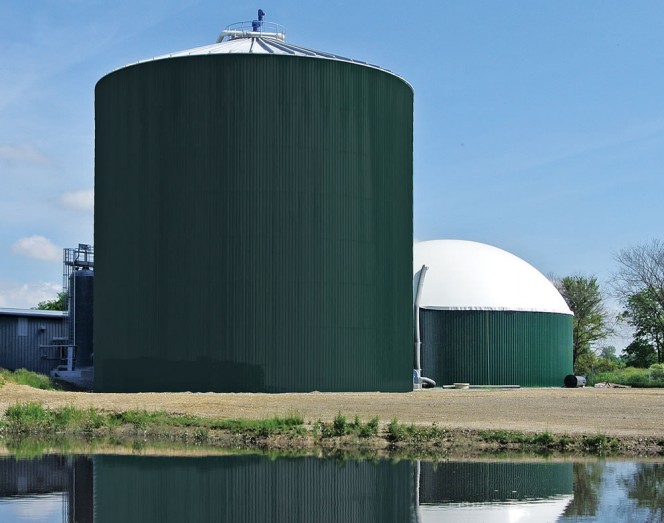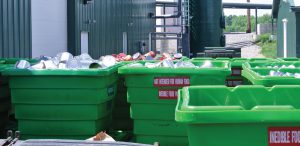Entrepreneur Connects Generators To AD
A Northeast company brings anaerobic digestion and renewable energy to the feedstock sources in Ohio and New York State.
By Dan Emerson BioCycle July 2015, Vol. 56, No. 6, p.34
Napoleon Biogas, LLC processes organic waste from a neighboring Campbell Soup Company plant in Napoleon, Ohio. Underground pipes transport the organics from the plant to the digester (shown in foreground; biogas storage unit on right).
Western New York is one of the top dairy-producing regions in the U.S. The by-products of making milk, cream, yogurt and other dairy products have certain characteristics that make them ideal fuel for anaerobic digesters designed to produce methane gas for the generation of electricity. “Dairy waste tends to have high fat and high protein content, and high acidity. The acidity is a problem when disposing of the material by land application, but not for digester systems like ours,” says Lauren Toretta, president of Greenwich, Connecticut-based CH4 Biogas, LLC. CH4, founded in 2008, has been focused on developing anaerobic digestion facilities that can consume food waste and make biogas to generate electricity. Lauren Toretta’s father, Paul Toretta, cofounded CH4 in 2008, along with Bob Blythe and Bigadan Holding.
CH4 formed Synergy Biogas, LLC to build, own and operate its first biodigester project in 2011 at Synergy Dairy, a 2,000-head dairy farm in Covington, Wyoming County, southwest of Rochester, New York. The Synergy facility uses the Bigadan anaerobic digestion technology; it was New York State’s first biogas plant specifically designed for codigestion of animal and food wastes. It processes manure from the host dairy, along with food waste transported to the site, totaling about 425 tons/day. There are two concrete receiving tanks (total capacity of 240,000 gallons), one to store the food waste substrates and one to store manure supplied by the farm. Manure and food waste are pumped via a macerator pump through the heat exchange system and combined in one of three pasteurization tanks (8,000 gallons each). Material is pasteurized at 160°F for an hour to kill pathogens, help improve gas production and reduce odors.
Pasteurized feedstock passes through the heat exchange system to bring the temperature down to the mesophilic range (about 100°F) and is pumped to a 2.2 million gallon digester vessel. Retention time in the continuous stirred tank reactor is about 22 days. Digested material is transferred to a storage tank where additional biogas is captured and stored, and is then pumped to screw press separators to produce solids for bedding. Digested effluent goes to a storage lagoon, and is applied to the dairy farm’s cropland.
Biogas is treated to reduce hydrogen sulfide, and then fed to a GE Jenbacher J420 engine to generate 1.4 megawatts (10,000 MW hours/year) of renewable electricity that is sold to the grid. The facility also reduces greenhouse gas emissions by the equivalent of 10,000 tons of CO2 each year, produces 16,000 yards of bedding for the dairy and reduces manure odors, according to CH4. Three employees manage the Synergy system. Funding for the facility included a $750,000 grant from National Grid’s (a utility) Renewable Energy and Economic Development Program, and $1 million of incentives from the New York State Energy Research and Development Authority (NYSERDA). The project also qualified for the U.S. Treasury’s now-expired 1603 program that covered 30 percent of eligible capital costs.
Campbell Soup Collaboration
CH4 Biogas LLC also designed, built and operates the Napoleon Biogas, LLC biodigester, which processes organic waste from a Campbell Soup plant in Napoleon, Ohio. Campbell’s Napoleon facility is its largest soup plant, and is responsible for more than two-thirds of the company’s beverage volume and over a third of its soup volume in North America. The Campbell Soup Company partnered with CH4 to build the AD system. The anaerobic digester is located on a 7-acre site across the street from Campbell’s plant. In 2013, the digester facility began accepting food waste and completed the connection to the Campbell plant. “Campbell was looking for sustainability, both economic and environmental,” Toretta explains. “It has an aggressive mandate around renewable energy, and was looking for ways to improve its processing.”
Packaged products with labeling flaws or other imperfections (above) are depackaged using an ALLU DL Screener Crusher.
The Napoleon digester also utilizes a Bigadan-made system, and is very similar in design to the Synergy facility. The only differences are that the digester serving the Campbell’s plant has two biogas engines instead of one, has depackaging equipment, and a slightly different dewatering system, according to Toretta. The Napoleon plant can process up to 425 tons/day of feedstocks. Organics coming from the soup plant includes spoiled vegetables and other ingredients that didn’t meet Campbell’s production standards, and packaged products with labeling flaws or other imperfections. Four-inch diameter, underground pipes carry the waste from the soup plant to the digester.
Napoleon Biogas also takes in manure from nearby farms and organic waste from a number of other major food processors in the area. Food waste from schools and grocery stores within a 60-to 90-mile radius is also delivered to the plant. Most of the waste is preconsumer, with some postconsumer material. The plant’s depackaging system includes an ALLU DL Screener Crusher, which is attached to a JCB 520 Telehandler. The ALLU unit is multipurpose: It transports organic material from where it is tipped, carries the load to the digester’s feeder and sizes the organics down to five-eighth-inch or less. The Screener Crusher also depackages canned liquids that have expired, or have been frozen or otherwise compromised and are unfit for consumption. Separated cardboard, plastic, metal and other packaging are recycled.
Although the Napoleon system is only “slightly larger” than Synergy’s, it generates twice as much electricity — about 25 percent of the soup plant’s energy needs — due to a different mix of inputs, i.e., less manure and more food waste, notes Toretta. “In terms of the agricultural and food producers we work with, it’s all very intertwined, and we’re part of that chain.”
This summer, CH4 plans to begin construction on its 15,000 square foot Genesee Biogas digester in the Genesee Valley Agri-Business Park in Batavia, New York. The Ag Park is home to two yogurt makers: Alpina Foods and Muller Quaker Dairy. Alpina currently sends its whey by-product daily to the Synergy Dairy digester in Covington. The Ag Park is owned by Genesee County Economic Development Council (GCEDC), the county’s industrial development agency. GCEDC officials wanted to attract a digester to the Ag Park to provide renewable energy to its tenants and provide an economical way to manage food processing waste from the yogurt plants.
To help finance the project, Genesee Biogas has received a $2 million Cleaner, Greener Communities grant from NYSERDA and a $1.5 million grant from Empire State Development, New York State’s economic development agency. CH4 has been working through the permitting process, and conducting preliminary engineering on the site, in preparation for breaking ground. The opening is projected for summer 2016. Like the Napoleon plant, the Genessee facility will have depackaging capability “to support the broader community,” says Toretta. “Bringing in new technology of any sort is always a challenge and there’s an (public) education process that goes along with that.”
Dan Emerson is a Contributing Editor to BioCycle.


